Home violet care basics: how to create a microclimate
Proper care requires some knowledge and skills, as well as a little experience that is acquired over time.
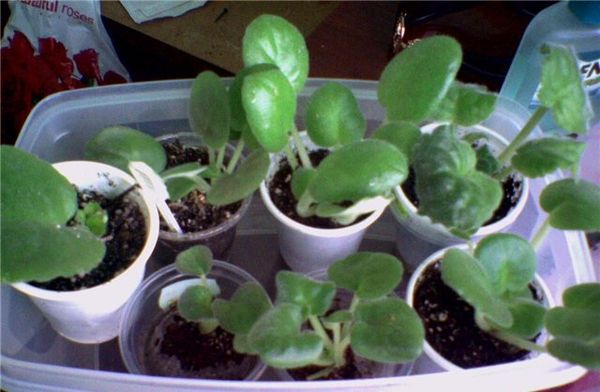
The right place for saintpaulia: lighting and temperature
Violet feels comfortable on the windowsills of east or west windows. When placed near the southern windows, the plant is shaded so that the sultry sun rays do not burn the delicate leaves. Her good lighting needed
.
- At noon in the warm season, you can diffuse the rays using a mosquito net or curtain.
- Violets grow at home at temperatures of twenty-one to twenty-two degrees.
- In severe frosts in winter and hot days in summer, it usually does not bloom.
Watering and moisture to grow
Violets are watered two to three times a week. The exact frequency of watering depends on humidity, season, and soil. They are watered as the topsoil dries out. In summer, it dries out faster, so the plant is watered more often. In winter, the frequency of watering is reduced
: moisten the soil only after the top layer of the substrate has completely dried.
A violet will more easily tolerate a slight drought than waterlogging, so it should not be flooded. Usually, after a while, the florist intuitively feels when the flower needs to be watered.

Pour on top with a thin stream, aiming at the edge of the container to avoid moisture getting into the outlet and on young leaves. Water is poured until it comes out of the drainage holes. After twenty minutes, the water is drained from the pan.
Topsoil in summer should not dry completely
.
Water the violet gently, pouring water along the walls of the pot, without getting on the outlet. Water for irrigation is used settled, melted or filtered.
Flowers are also adversely affected by dry indoor air due to central heating. In this case, the required air humidity is created.
Feeding a houseplant
Violets are fed with complex fertilizers, which are sold in specialized stores. Fertilizers include nitrogen, phosphorus and potassium. Nitrogen helps the leaves to develop actively, phosphorus helps to bloom. Leaves need potassium for firmness
... It also makes the colors appear faster.
Transplant, selection of soil and pot
It is not recommended to use old planting containers with salt deposits. When transplanting, take a pot larger than the previous one. It is advised to use plastic pots. The soil should contain peat and sand.
Good drainage is laid at the bottom of the pot, consisting of expanded clay or sphagnum moss. Then the plant is transplanted with partial or complete soil replacement or transfer method.
The transshipment method is used, if a flowering violet is transplanted
, baby or flower with a large rosette. Then a lump of earth is removed from the pot and placed in a new one. On the sides, the space is covered with earth.
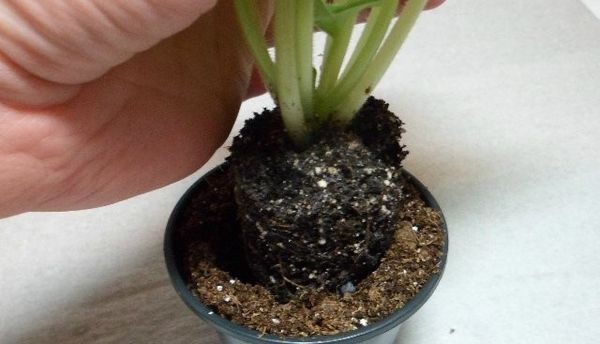
The beautiful violet has come a long way from natural habitat to home conditions.
She attracted the attention of the discoverer with bright colors with a contrasting center. This beauty also attracts flower growers all over the world, who turn the cultivation of violets into a hobby of their life.
Indoor violet is such a beautiful and delicate plant that even prejudices about impending loneliness will not prevent you from starting it. For some reason, it was believed that the flower has excess feminine energy, and this will not allow its owner to find a pair.
Fortunately, most houseplant lovers do not pay attention to slander and gladly breed violets on the windowsills. In gratitude, they bloom all year round, pleasing the eye with bright inflorescences of all shades of the rainbow.

Violets, or Saintpaulias, from the Violet family, decorate the interior of houses around the world, but their homeland is Africa. There flowers grow along river beds and near waterfalls, as they like high humidity.
Direct sunlight is detrimental to the fleshy leaves of the plant, so it is low so that it can hide under the branches of trees and shrubs. The flower grows in the form of a rosette. Its diameter ranges from 6 to 60 cm.
The indoor violet feels best on a window facing east or north, when the bright sun does not burn the leaves and inflorescences.
In nature, the plant reproduces with the help of rhizomes and fruits filled with seeds. At home, the cut leaf is placed in a jar of water and after it has given roots, it is transplanted into moist soil.
The velvety leaves of the plant are oval in shape with smooth or jagged edges. Currently, breeders have bred several tens of thousands of species of violets with a variety of colors.
Fairy flower
The home violet has become a truly fabulous flower. See what a variety of colors, shapes, sizes! For every taste. There are large violets with huge flowers, there are mini and microfillets growing in a small glass, ampelous with hanging branches, trailer in the form of a blooming ball. And what a variety of shapes and colors of flowers! Simple, double, all kinds of colors, multi-colored, speckled, so-called fantasy varieties, striped chimeras! And more and more new varieties appear.
The popularity of home violets is only growing. She won the hearts of millions of people around the world. The home violet blooms successfully under artificial lighting all year round in the apartment, which is especially pleasant in the conditions of the polar night in the far north. The industrial production of home violets has been established, and special varieties have been developed for this. Societies were created that unite collectors of violets in various countries, exhibitions and auctions of Saintpaulias are held.
All the variety of modern violets is obtained through the selection of African plants. Of course, there are many external differences between modern house violets and their ancestors in East Africa. But the home violet will develop and bloom successfully in conditions similar to those of the homeland. Therefore, it is necessary to study these conditions.
Homeland violets room
East Africa, Ulugur and Uzambar mountains, mountainous and coastal regions of Kenya and Tanzania - this is the birthplace of our violets. The tropical forests of the subequatorial belt grow here. The climatic conditions in this part of Africa are even throughout the year, the temperature is not subject to special fluctuations (from +21 to +38 degrees) and stays around +25 degrees, the daylight hours do not change and at any time of the year is 12 hours.
Precipitation falls all year round, but sharply decreases in spring and autumn. Bright sunlight is scattered by clouds, and violets grow in the shade of tropical trees, shrubs, ferns and other plants and are hidden from direct sunlight. They can endure the bright light of the sun for a very short time.
The mountains of East Africa are old mountains, hills covered with moss. Violet can be found in mountain forests and shrubs, on the terraces of mountain rivers, often found on rocky areas, in crevices, cracks in rocks, between boulders, near waterfalls, it needs water nearby.
Sometimes it can be found on old trees, growing like epiphytes. In violets, the roots are adapted to use a small amount of nutrient substrate. During the dry season, violets have a moisture reserve in juicy thick leaves.
Favorable conditions for the development of home violets
Knowing these natural and climatic conditions for the growth of the wild uzambara violet in its natural conditions, we can list the conditions for the normal development of its room sister:
- High air humidity;
- The temperature is not higher than +25 degrees;
- Small pots, so that the roots of home violets can penetrate the entire space of the pot;
- the ground mixture for violets should be light and airy, it is desirable to contain moss, leaf humus.
But how does the uzambar violet reproduce in the wild? Violet pollen is difficult for insects to obtain, but they have learned to reproduce in a vegetative way. During a tropical rainstorm, the leaves break and are washed away by water, get stuck in crevices and cracks in the rocks, and, as long as there is enough moisture, they have time to take root.
Isn't it true that the mailing list of leaf cuttings spreads varieties of home violets as well as African tropical showers?
The transformation of a humble African violet into a lush queen of home flowers is a separate story, which you will learn more about later.
It has become difficult for the Uzambar violet to survive in its homeland. Due to deforestation, there are fewer places suitable for its habitat. The video below will help you better imagine the homeland of the Usambara violet.
{SOURCE}
Violets - leaf propagation, rules, features, nuances
With the help of seeds, these flowers are bred by growers engaged in the development of new varieties.
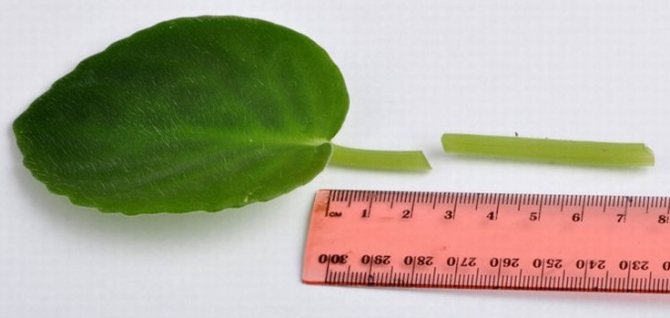
At home, the uzumbar violet can multiply by shoots or leaves - the so-called cuttings. It is very easy to plant an offshoot or leaflet that has taken root in a pot with moist soil, and after a while you will have a mature plant.
Reproduction of violets by a leaf, at home, is carried out as follows, the leaves are plucked immediately under the flower stems or the leaves of the second tier. Such leaves should be grown, mature, have a stem of 3-4 centimeters. They are cut off at an angle with a thin-bladed knife and placed in settled water. All leaves require their own space - therefore, each has its own container of water. It is not customary to replace water entirely, but it will need to be added when the level in the container decreases.
After the roots appear, the leaves are planted in pots with a slope, while making sure that the leaf does not lie on wet ground (for this, you can put something under it, for example, a piece of plastic, a small stone). The earth around the leaf is not tamped, but left loose. From such a leaf, small young leaves will grow, which will gradually form a rosette. When young leaves begin to grow, the planted leaf can be trimmed. Typically, several small plants grow in a pot. Then they are divided and seated in different pots.
The origin of the violet: history and where it comes from
Violet is an annual or perennial herb with a short stem, on which leaves collected in a rosette with strong pubescence are kept. They take the form of an oval, circle or heart. The edge of the leaves is flat or wavy, depending on the type of flower.
Breeders have bred a large number of varieties that differ in flower size and color. For different varieties, the size of the rosette ranges from seven to forty centimeters. The root system of the violet is thin and creeping.
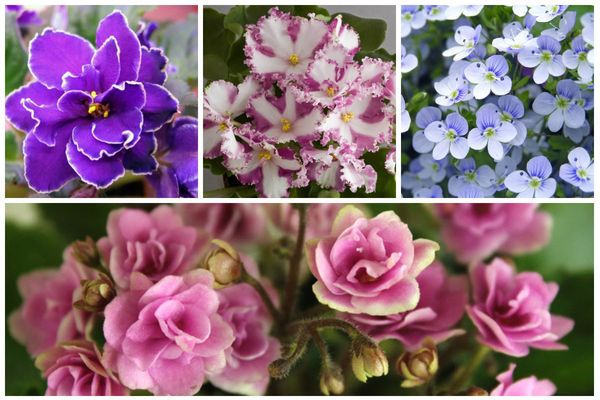 The abundance of violet species is the merit of the breeders
The abundance of violet species is the merit of the breeders
Flowers, double or simple, are collected on pedicels in several pieces. They come in different colors: blue, pink, white, burgundy, blue.
The flowers of violets contain anthocyanin glycosides, essential oils. Thanks to these substances, the flowers of the plant are useful in the treatment of eczema, urticaria, and shingles. The violet fruit is a box with valves.
The country is the birthplace of the flower, the nature of the violet
The birthplace of the flower is Africa. It is difficult to name a specific country. The plant grows naturally in temperate weather. Most often it can be found in North America, Japan and the Andes. Some varieties grow in the subtropics of Brazil, tropical and South Africa.
The violet is found on the Australian continent, New Zealand and the Sandwich Islands. Almost all species choose open or slightly shaded areas with a moderately humid climate as their habitat.
Wild violets grow in Europe, in the south of Siberia. Forest ones are found in forest clearings in deciduous forests.
The botanist Hermann Wendland recorded the violet as a separate genus. She received the name Saintpaulia from him in honor of Baron Saint-Paul, who was the president of the German dendrological society. It was he who gave Wendland the seeds of the plant.
Baron Adalbert Saint-Paul in 1892 discovered a flower in East Africa among the stones while walking with his beloved. He noticed on the stone flowers of blue color with a yellowish center, which are located in a crevice.
The Baron sent the flower to his father Ulrich von Saint-Paul, who collected a collection of rare plants. In 1893, the plant family was identified: Gesneriaceae. In the same year, the violet was shown for the first time at the exhibition. She has been featured in magazines. In Germany, it was called "Uzambara" after the name of the area in Tanzania, where it was found.
Uzambara violet, description
This flower is a short herbaceous plant with a shortened stem and a rosette of numerous long-petiolized leaves. The leaves are velvety, oval, round or ovoid, with a heart-shaped base. Depending on the variety, the upper side of the leaves is varied in color: from light to dark green, the lower side is pale green or purple, with sharply protruding veins.

Photo of pink uzambara violet
The flowers of this type of violet are medium-sized. Their number on one peduncle is from 3 to 7. During mass flowering, one plant can simultaneously have up to 80-100 flowers. Flowering lasts up to 8 months. Currently, about 1200 species of this plant have been bred. All of them are different in size, color and shape of leaves and flowers. The appearance of the flowers is striking in its variety: they can be both simple and double with fringed and wavy petals, and the color is white, pink, crimson, blue, blue, purple, two-color.
Homeland, history and description of the species of violets
The homeland of the flower is East Africa, more precisely, its mountainous areas. Most of the species are found in Tanzania. There are especially many violets growing in the Usambar mountains. Some plant species are found in Kenya, which also belongs to the countries of East Africa.
The flower was discovered in the 19th century by the German baron Saint-Paul. The discovery took place in the Uzambar district, which at that time was considered a German colony. Today this territory belongs to the state of Tanzania.


While walking, the baron drew attention to an unknown flowering plant. The discoverer's father was a famous dendrologist
The seeds he received from his son, he, in turn, passed on to the botanist Wendland. In 1893, a botanist described a plant grown from African seeds. He named the flower Saintpaulia Violet-flowered.
The first word is derived from the surname of the discoverer, Baron Saint-Paul. The flower received the second word in the name for its striking external resemblance to representatives of the Violet genus of the Violet family. The plant was allocated to a separate genus of clear-flowered dicotyledonous plants and was assigned to the Gesneriaceae family.
In the same year, the plant was presented at the international flower exhibition in Ghent. The right to cultivate on an industrial scale was immediately bought out by the well-known German company Benari.


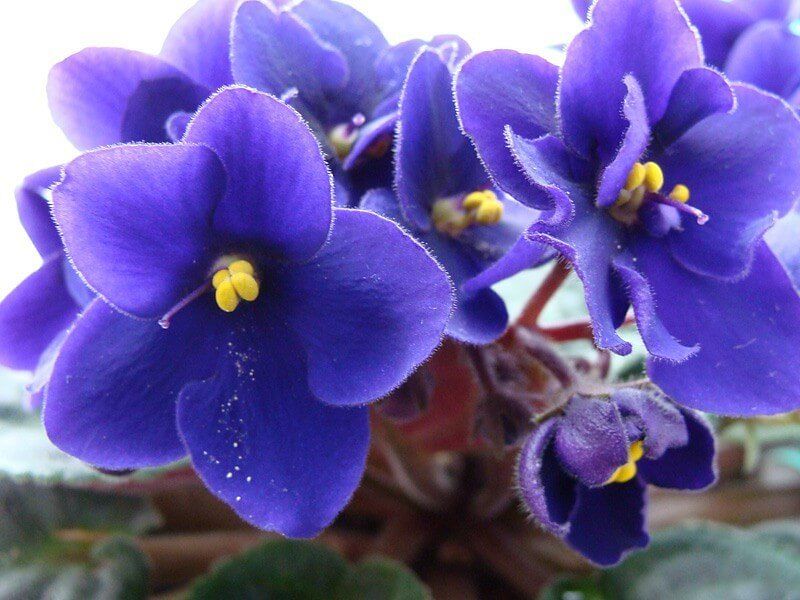
After 30 years, Saintpaulias have conquered the United States as indoor flowers. At the turn of the 19th and 20th centuries, more than 100 varieties of this culture were known. Today this figure is over 32,000.
Due to the huge number of hybrids, it is very difficult to classify Saintpaulia. Most growers use the American version of the classification. This model is an ordered system of classifications, consisting of the following items:
- Socket size.
- Leaf type.
- Leaf color.
- Flower type.
- The color of the petals.
By the size of the rosette of leaves, the following types of Saintpaulias are distinguished:
Varieties of violets with names, photos and descriptions
Depending on the size and position of the petals, there are 5 types of indoor violets:
- pansies;
- star;
- bell;
- bowl;
- wasp.
Violet "pansy" (eng. Pansy) - its corolla consists of 5 petals, and the size of the two petals of the upper row are smaller than those of the lower three. In this form, the following varieties of home violets are distinguished:
Violet Lyon's Pirate's Treasure (S. Sorano breeder)
with bright pink flowers with a wide crimson edging along the edge. On the border of the main color and the border, the petals are strewn with a scattering of small dots of dark crimson color. The leaves of the indoor violet, forming a rosette, have a bubbly texture.
Violet Melodie Kimi (Sunnyside / Levy breeder)
with a symmetrical rosette made of "quilted" corrugated sheet plates. A white simple violet flower has two blue upper petals and a border of the same color on the main background.
Violet "Star" (eng. Star) is characterized by the same size of petals located in any row, and their uniform arrangement around the center. In this form, the following varieties of Saintpaulias can be distinguished:
Violet EK-Goddess of Beauty (breeder Korshunova)
with a large basal bush consisting of dark green leaves. The inflorescences are formed by bright pink double stars with tints of purple-violet tones.
Violet Austin's Smile (breeder LLG / P. Sorano)
with a large rosette of dark green color and large single flowers-stars of coral pink color with a dark pink eye and a crimson border.
Violet "Bell" (eng. Bell) has petals fused at the base. This feature does not allow the flower to open completely, as a result of which it acquires a resemblance to a bell. This species includes the following varieties of indoor violets:
Violet EK-Admiral (Korshunova breeder)
with large cornflower blue semi-double bell flowers with a wavy edge. The pointed dark green leaves of the home violet have a creamy purple edging.
Violet Saintpaulia Rob's Dandy Lion (breeder R. Robinson)
with large inflorescences-bells of greenish-cream color, resembling snowdrops in shape. Violet rosette consists of dark green leaves with slight white variegation.
Violet "Bowl" has petals that have not grown together at its base, but the flower never fully unfolds and retains its shape throughout the entire flowering. In this form, the following varieties of Umazbar violets are distinguished:
Violet Boo Man (Breeder S. Sorano)
differs in double or semi-double cupped flowers. The violet flowers are pale blue, the upper petals are white, sometimes with light green, 2.5-3 cm in diameter. The leaves are spoon-shaped, dark green.
Saintpaulia Ming Dynasty (breeder I. Fredette)
a variety with strongly corrugated cup-shaped flowers of a snow-white color, the edges of the petals of which have a pink or lilac hue. There are terry and semi-double violets. The leaves of the rosette are wavy, characterized by pronounced variegation.
The Wasp violet has completely separated petals, two of which roll up into a tube, and three elongated ones hang down. In this group, the following varieties of indoor violets are distinguished:
Violet Lunar Lily White
with a small basal bush and light green leaves of "quilted" texture. Violet inflorescence consists of 3-8 white simple and semi-double flowers, about 4 cm in size.
Saintpaulia PL-Zemfira (breeder L. Pchelovodov)
with a medium rosette of green leaves with variegation in the center and simple or semi-double lilac tubular flowers with corrugated edges.
Saintpaulia Spootnik (Sputnik) (breeder J. Dates)
with a rosette about 15 cm in size and light green leaves up to 5 cm long. Violet flowers have a red-violet color.
Saintpaulia in indoor floriculture [edit | edit code]
Varieties
Saintpaulia has long been used in indoor floriculture, and to date, many varieties of this plant have been bred. Most of them are hybrids of Saintpaulia violet ( Saintpaulia ionantha ), as well as interspecific hybrids Saintpaulia ionantha and some other types of Saintpaulia ( Saintpaulia magungensis , Saintpaulia comfusa ). In floriculture, a general name is sometimes used for all Saintpaulia hybrids. Saintpaulia hybrid (Saintpaulia hybr>.
Saintpaulia varieties are divided into several groups, first of all, according to the color and shape of the flowers and their type. According to this principle, there are classical, star-shaped, fantasy, rimmed Saintpaulias and Saintpaulias-"chimeras".
By the type of leaves, plants are primarily distinguished as "boys" (English boy) and "girls" (English girl). In plants-"girls" on the upper side at the base of the leaf there is a light spot, in varieties of the "boys" group the leaves are completely green. The most common are Saintpaulias with rosettes, the diameter of which varies from 20 to 40 cm. There are giant varieties (diameter from 40 to 60 cm), miniatures (up to 15 cm) and even the so-called microminiatures; in the latter plants, the rosette diameter is only about 6 cm.
Modern varieties often convey varietal characteristics much worse than varieties of earlier breeding, for example, the selection of B.M. Makuni
- Saintpaulia ‘Chimera Monique’ - the flowers of this variety have lilac petals with a white border.
- Saintpaulia ‘Chimera Myrthe’ - The flowers of this variety have pink-red petals with a white border.
- Saintpaulia ‘Ramona’ is a variety with deep pink double flowers with yellow anthers in the center.
- Saintpaulia 'Nada' is a white-flowered cultivar.
Agrotechnics
Saintpaulia pots shouldn't be too big.
The diameter of the pot should be three times smaller than the diameter of the rosette of the violet. >
It is best to place the pots on a west or east orientation window. In order for the plant to be illuminated from all sides, it is periodically turned. Artificial lighting can be used to make Saintpaulia bloom all year round. Fluorescent lamps are best suited for this purpose. The optimum temperature is 20-22 ° C, without sudden fluctuations. Saintpaulias are afraid of cold drafts and direct sunlight.
As a soil, you can use purchased soil for Saintpaulias or a mixture of leaf, sod, coniferous and peat soil in a ratio of 3: 2: 1: 1 with the addition of leavening agents - perlite, vermiculite, coarse river sand and chopped sphagnum.
Water the saintpaulias as the earthen coma dries. The soil must be constantly moist, but care must be taken so that moisture does not stagnate in the roots. It is better to water along the edge of the pot so that the water does not get on the leaves. In no case should you pour cold water on Saintpaulia. In indoor floriculture, the wick irrigation method is also common.
Top dressing complex mineral fertilizers are produced regularly during the period of growth and flowering, about once every 2 weeks.
Air humidity must be at least 50%. Spraying plants is undesirable. This can only be done during flowering, and the water should be sprayed very finely. You can put the pot on a tray of damp pebbles or place it among other plants.
Due to the decrease in the length of daylight hours in winter, it is better to use additional artificial lighting. Its duration should be 11-13 hours a day. At temperatures below 15 ° C, lighting does not bring tangible results - all processes in plants slow down. In winter, watering should be limited a little.
Saintpaulias are easy to propagate by leafy cuttings, part of the leaf and daughter rosettes. The most common way is with a leaf cut. This requires a healthy, formed leaf. A sluggish, drooping leaf tends to rot. The length of the petiole should be 2-3 cm.The stalk is placed in water until roots are formed (some large-leaved varieties can immediately form babies) or planted in loose soil to a depth of no more than 1-2 cm
The seedling is watered with water at room temperature and covered with a plastic bag to maintain air humidity, while it is important to ensure that condensation does not form, and when it forms, ventilate the bag. Temperature - not lower than 20-22 ° C
Root formation and development of babies lasts up to 1-2 months.
You can also propagate saintpaulias by seeds. Reproduction of Saintpaulias by seeds occurs with splitting of traits, and seedlings may not inherit traits from their parents.
Legends: the place in history where they grew up
Many legends, stories, myths, signs and superstitions are associated with the violet. They talk about where the flower comes from and how it could have been born in general.
The ancient Greeks dedicated a whole legend to the violet, telling about its origin. Once the god of light and sun Apollo incinerated a young nymph with hot rays. The girl, exhausted from the heat, with her last strength asked for help from the great Zeus.
According to legend, Zeus created a violet, saving it from Apollo
He took pity on the poor thing and turned her into a violet, sheltering her from the scorching sun in a shady forest near the bushes. He hid it on purpose so that no one but him could admire the gentle beauty. He alone could enjoy the beauty of the violet until the day his daughter Persephone came to the forest for a walk.
She found a beautiful violet and plucked a bouquet. When Persephone turned back, she was kidnapped by Hades. Frightened, she dropped the bouquet, and delicate flowers woke up from Olympus to the ground.
Among the ancient Greek legends there is another story about the appearance of the violet. Once the goddess of love and beauty Aphrodite wanted to plunge into the gentle waters of the grotto, but noticed several men who were spying on her, wanting to contemplate the ideal body of the goddess.
According to another legend, violets appeared at the request of Aphrodite
She got angry and demanded from Zeus the most cruel punishment for the curious - death. Zeus did not fulfill his harsh will and turned men into beautiful flowers that still resemble prying eyes.
If the flower dies, it is believed that she took the disease of the tenant for herself. When someone is sick in the house, the plant gradually withers away, sharing his pain with the sufferer. Violets of different colors have different functions.
White flowers help young children fight aggression. Varieties with white flowers are recommended for people with a fine mental organization: a person ceases to be upset over trifles and is less anxious. White violets help to survive a break with a loved one and cleanse the soul from quarrels.
Red and pink flowers have a beneficial effect on health. Red varieties help in the fight against addictions and bad habits.
Varieties with red and pink flowers help to overcome depression.
Purple flowers are recommended for people with the professions of a psychologist and teacher. This color is a symbol of wisdom and spirituality. Purple violets help to find a common language and establish contacts.
In addition to useful moral influence on a person, they can also bring practical benefits. They say that they can drive ants out of the house. Violet is an indicator of a healthy family and a favorable psychological environment in the house, so it should be carefully looked after.
Growing violets
Having decided to settle a flower of sympoly in your house, you need to arm yourself with certain knowledge. And you need to start by choosing a plant. When buying a flower, you must carefully examine it. Violets should have healthy, without damage and spots, leaves of a bright green hue, a dense growth point. Also, experienced florists have a rule: they buy flowers in specialized stores with a tag in which the variety and even the planting date are necessarily registered.
After purchasing an indoor flower, you need to take care of a pot for it, because after the plant adapts it will need to be transplanted.
The best option is a flowerpot with a diameter of six to twelve centimeters. The pot can be either clay or plastic. Without fail, holes must be provided in it to drain excess fluid.
To grow uzambara violets, a certain soil is also required. It should be lightweight, breathable and well water-conductive. Flower shops sell special substrates for Saintpaulias. But you can prepare an earthen mixture for violets yourself. To do this, you need to take:
- two pieces of land;
- floor of a piece of turf;
- one part of humus;
- one piece of sand.
All components must be mixed and bone meal and superphosphate added to them. Flour and fertilizer are added at the rate of ten kilograms of the prepared substrate, half a glass of bone meal and one tablespoon of superphosphate.
After all the preparatory work has been carried out, the violet can be transplanted into a new pot.
Transplanting Saintpaulia. Not only recently purchased flowers are transplanted, but also home specimens that need annual renewal of the soil, which is significantly depleted. This process is best done in the spring, although indoor violets are quite capable of safely transferring a transplant at any time of the year.
In transplanting Saintpaulias, it is important to choose the right pot. It should correspond to the size of the root system, and be three times smaller than the rosette of the flower.
If the flowerpot is too large, rot may develop on the roots.
Before planting a flower, the pots undergo a special treatment. Plastic ones are dipped in boiling water for a couple of minutes, and clay ones are kept in hot water for at least forty minutes.
Now you need to take care of the drainage layer, it should make up one fifth of the pot. For drainage, crushed clay shards, river sand, expanded clay are used.
Then the pot is filled with the prepared substrate and Saintpaulia is planted in it. The planting depth should be such that the petioles of the lower leaves are located slightly above the ground.
If you deepen the plant too much, then its growth point rots and the flower dies.
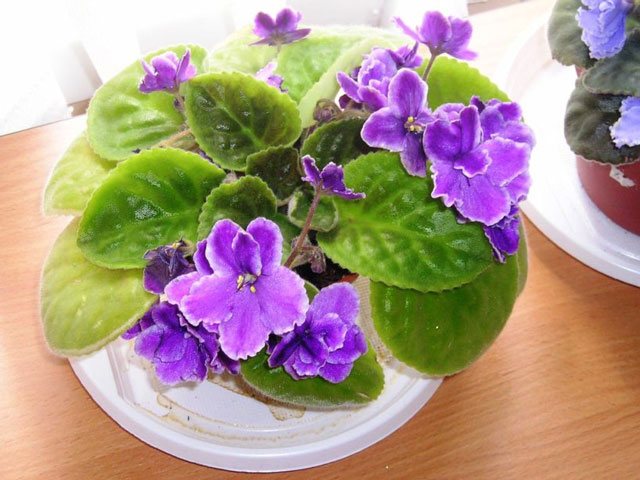
The history of the violet
Many are interested in the question of when and where the violet appeared. The native land of the plant is the Uzambar and Ulugur mountains of East Africa. Violet is called "uzambar" in honor of the mountains where it was first discovered. Another name - "Saintpaulia" - the violet received in honor of its discoverer - Baron Walter von Saint-Paul, who, being the governor of this country, was captivated by the beauty of unfamiliar flowers. Delighted by the pale blue glow that emanated from the plant, the Baron sent the violets to his father, who at that time was a famous florist and orchid collector. The latter showed them to the director of the botanical garden in Hanover.
Having studied Saintpaulia, it was assigned to the Gesneriaceae family (perennial, dicotyledonous plants). The official date of the “birth” of the violet is considered to be 1893, when it was presented at the international flower exhibition and described in the popular magazine Gartenflora. The flower earned recognition and went to decorate the windowsills and flower beds of houses around the world.

Possible problems
Due to improper care, the plant can be sore and affected by pests.
Diseases
Most often, the houses of Saintpaulia are affected by such diseases:
- rot of leaves and roots;
- gray rot;
- powdery mildew;
- fusarium;
- late blight;
- bronze.
Pests
In the process of growing, violets are capable of infecting such pests:
- aphid;
- nematode;
- thrips;
- mealybug;
- sciarids.
Other problems
Sometimes the leaves of the plant can fade and turn yellow. The problem is solved by turning on additional lighting, feeding.
The Uzambara violet is the real queen of the windowsill.With its beautiful and long-blooming flowers, it gives positive emotions, decorating any room.
All about violets
Natural growing area
The progenitors of modern indoor pets grow up in Africa. The massifs of the Ulugur and Usambar (uzambar) mountains are the natural areola of saintpaulias, most of the varieties are located on the slopes of the latter and therefore received a second name, the usambar (uzambar) violet.
Violets in nature.
In East Africa, violets grow in humid climates, often near waterfalls, on river terraces. In such conditions, there is a lot of water dust and fog, and the soil is light and allows moisture and air to pass through well.
Origin story
The description of indoor plants should begin with the history of their finding in nature.
Walter von Saint-Paul, Commandant of the Usambar District of German East Africa - German Colony. In 1892, studying the flora and fauna of the territories subordinated to him, he discovered flowers in the mountains, collected seeds to understand what kind of plant it was.
Then they were sent to his father, who was the president of the German Dendrological Society, Ulrich von Saint-Paul, so they got to Hermann Wendland.
The scientist called the cultivated plant grown in 1893 Saintpaulia, and for the shape of the flower the name was given to the addition of violet. This species was singled out as a separate genus, named after the father and son of those who discovered it.
Further, the flower was presented at an exhibition in Goethe, where the rights to cultivate on an industrial scale were bought by the Benari company.
Violets were introduced to the United States in 1927 and were recognized there as ideal indoor plants. From that moment on, the mass breeding of new varieties began and by 1949 there were already 100 of them, and today their number is more than 32 thousand.
Important! More than 2000 varieties were bred by domestic breeders.
Biological classification
So, what is a violet from a biological point of view - is it a herb or not? Saintpaulias are assigned to a separate genus - they are evergreen herbaceous plants of the Gesneriaceae family.
The structure of the room violet is as follows:
- the stem is shortened, which leads to the formation of a rosette of leaves;
- the leaves are suitably arranged in rows and are very close to each other;
- leaves on the stem, round, fleshy and leathery, covered with villi;
- the base of the leaves is usually slightly heart-shaped, and the top is rounded or slightly pointed;
- the color of the leaves varies from dark to light green, there are also variegated-spotted, sometimes almost white.
Further, is the violet a monocotyledonous or dicotyledonous plant? The house plant, the violet, is dicotyledonous. Flowers collected in a cluster usually have five petals, several stamens and one pistil. The calyx consists of five sepals located on a receptacle. The violet color scheme is shown in the picture below.
Violet flower structure.
After pollination, a seed box is formed. The seeds themselves are very small, have an average germination rate, which is lost over time.
Based on this information, you can add the passport of a houseplant:
-
plant passport in biology:
- Kingdom: plants;
- Department: flowering;
- Class: bipartite;
- Order: clear-colored;
- Family: Gesneriaceae;
- Genus: Saintpaulia;
- Application: indoor plants;
- Natural areola: mountainous areas of eastern Africa.
-
plant passport violet for kindergarten simplified:
- Kingdom: plants;
- Department: flowering;
- Genus: Saintpaulia;
- Usage: indoor plants.


